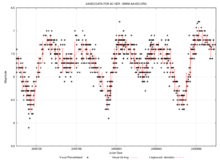AC Herculis
| Observation data Epoch J2000.0 Equinox J2000.0 (ICRS) | |
|---|---|
| Constellation | Hercules |
| Right ascension | 18h 30m 16.23850s[1] |
| Declination | +21° 52′ 00.6080″[1] |
| Apparent magnitude (V) | 6.85 - 9.00[2] |
| Characteristics | |
| Evolutionary stage | Post-AGB[3] |
| Spectral type | F2pIb-K4e(C0,0)[2] |
| U−B color index | +0.17 - +0.94[4] |
| B−V color index | +0.52 - +1.09[4] |
| Variable type | RVa[2] |
| Astrometry | |
| Radial velocity (Rv) | −30.00[5] km/s |
| Proper motion (μ) | RA: -2.82 ± 1.12[1] mas/yr Dec.: -0.18 ± 1.16[1] mas/yr |
| Parallax (π) | 0.44 ± 0.29[6] mas |
| Distance | 1,600±300[7] pc |
| Orbit[7] | |
| Period (P) | 1,194 days |
| Semi-major axis (a) | 2.7 AU |
| Eccentricity (e) | 0.12 |
| Inclination (i) | 50° |
| Details[7] | |
| A | |
| Mass | 0.6 M☉ |
| Radius | 61 R☉ |
| Luminosity | 2,500 L☉ |
| Surface gravity (log g) | 0.65 cgs |
| Temperature | 5,225 K |
| Metallicity [Fe/H] | −1.5 dex |
| B | |
| Mass | 1.2 M☉ |
| Other designations | |
| Database references | |
| SIMBAD | data |

AC Herculis, is an RV Tauri variable and spectroscopic binary star in the constellation of Hercules. It varies in brightness between apparent magnitudes 6.85 and 9.0.
AC Her is an RVa star, meaning it is an RV Tauri variable whose maximum and minimum magnitudes do not slowly vary over hundreds of days. It also is a very clear example of a common type of RV Tauri light curve where the maximum following a deep minimum is brighter than the maximum following a shallow minimum. In each period of 75 days it has two maxima and two minima.[8]
AC Her is also a binary star, although the secondary can only be detected by its effect on the radial velocity of the primary. The invisible secondary is more massive than the supergiant primary, so the primary moves at relatively high velocity in its three years and three months orbit. The two stars are also surrounded by a dusty disc filling the region between 34 and 200 astronomical units (AU).[7]
Little is known of the secondary star except that its mass is around 1.2 M☉, deduced from the mass ratio of the binary system and the modelled mass of the primary star. The primary itself is calculated to have a mass of 0.6 M☉, but a luminosity of 2,500 L☉. It is slightly cooler than the sun, although this varies by over a thousand K as the star pulsates.[4]
The total system mass can be estimated from the dynamics of the disc, and this gives a value of 1.5 M☉, slightly lower than from other methods.[3]
References
- 1 2 3 4 van Leeuwen, F. (2007). "Validation of the New Hipparcos Reduction". Astronomy and Astrophysics. 474 (2): 653–64. arXiv:0708.1752
 . Bibcode:2007A&A...474..653V. doi:10.1051/0004-6361:20078357.
. Bibcode:2007A&A...474..653V. doi:10.1051/0004-6361:20078357. - 1 2 3 Samus, N. N.; Durlevich, O. V.; et al. (2009). "VizieR Online Data Catalog: General Catalogue of Variable Stars (Samus+ 2007-2013)". VizieR On-line Data Catalog: B/gcvs. Originally published in: 2009yCat....102025S. 1. Bibcode:2009yCat....102025S.
- 1 2 Bujarrabal, V.; Castro-Carrizo, A.; Alcolea, J.; Van Winckel, H. (2015). "Detection of Keplerian dynamics in a disk around the post-AGB star AC Herculis". Astronomy & Astrophysics. 575: 4. arXiv:1502.01607
 . Bibcode:2015A&A...575L...7B. doi:10.1051/0004-6361/201525742.
. Bibcode:2015A&A...575L...7B. doi:10.1051/0004-6361/201525742. - 1 2 3 Dawson, D. W. (1979). "A photometric investigation of RV Tauri and yellow semiregular variables". Astrophysical Journal Supplement Series. 41: 97. Bibcode:1979ApJS...41...97D. doi:10.1086/190610.
- ↑ Gontcharov, G. A. (2006). "Pulkovo Compilation of Radial Velocities for 35 495 Hipparcos stars in a common system". Astronomy Letters. 32 (11): 759. Bibcode:2006AstL...32..759G. doi:10.1134/S1063773706110065.
- ↑ Gaia Collaboration (2016). "VizieR Online Data Catalog: Gaia DR1 (Gaia Collaboration, 2016)". VizieR On-line Data Catalog: I/337. Originally published in: Astron. Astrophys. 1337. Bibcode:2016yCat.1337....0G.
- 1 2 3 4 Hillen, M.; De Vries, B. L.; Menu, J.; Van Winckel, H.; Min, M.; Mulders, G. D. (2015). "The evolved circumbinary disk of AC Herculis: A radiative transfer, interferometric, and mineralogical study". Astronomy & Astrophysics. 578: A40. arXiv:1503.03984
 . Bibcode:2015A&A...578A..40H. doi:10.1051/0004-6361/201425372.
. Bibcode:2015A&A...578A..40H. doi:10.1051/0004-6361/201425372. - ↑ Preston, G. W.; Krzeminski, W.; Smak, J.; Williams, J. A. (1963). "A Spectroscopic and Photoelectric Survey of the RV Tauri Stars". Astrophysical Journal. 137: 401. Bibcode:1963ApJ...137..401P. doi:10.1086/147520.